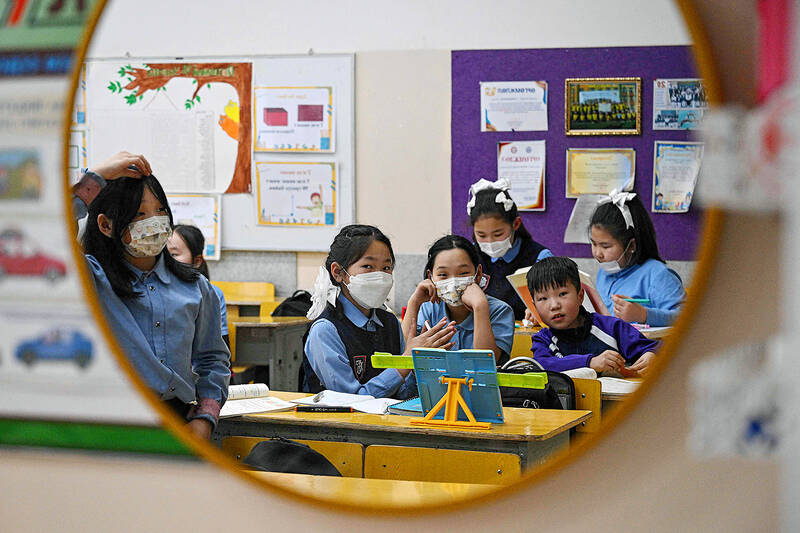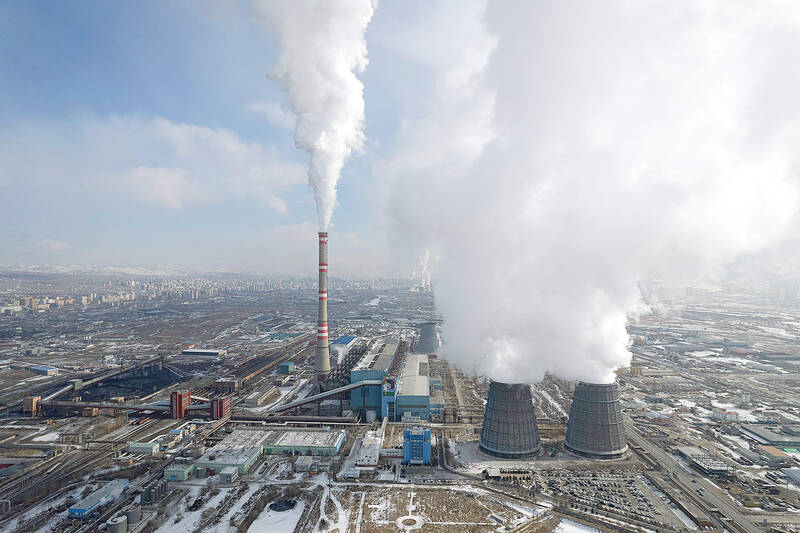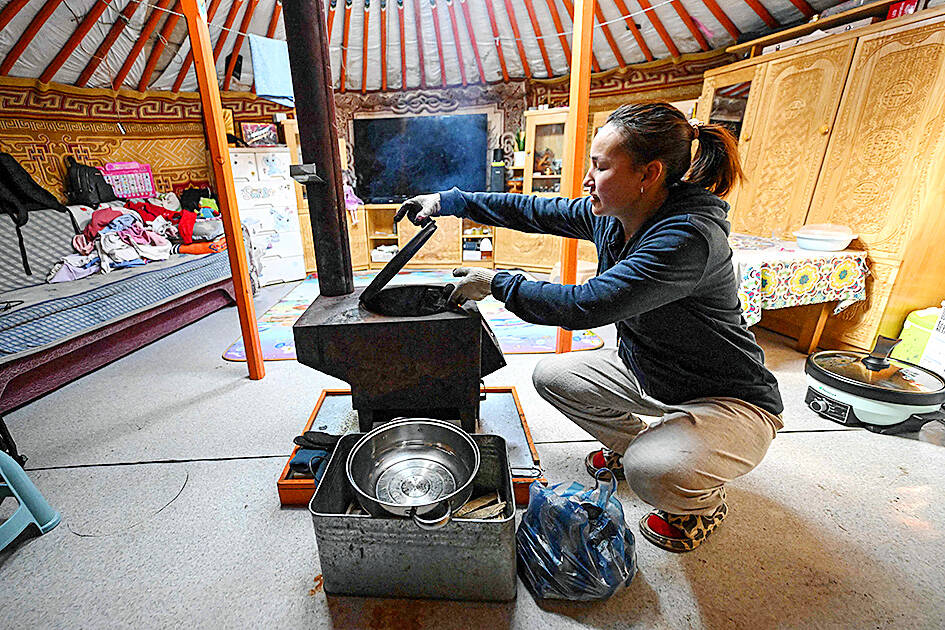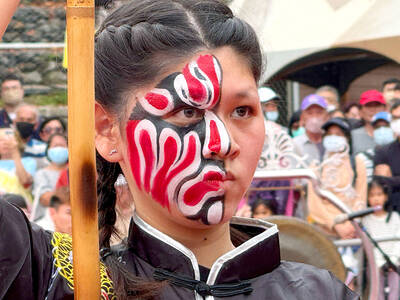As she watched her five-month-old son lying in intensive care, wires and tubes crisscrossing his tiny body, Uyanga cursed her hometown Ulaanbaatar and its chronic pollution.
The toxic smog that settles over the Mongolian capital every winter has been a suffocating problem for more than a decade that successive governments have failed to dispel.
There are wisps of hope in a resurgent grassroots movement and a promised official push to action.

Photo: AFP
But the statistics are grim.
Respiratory illness cases have risen steadily, with pneumonia the second leading cause of death for children under five.
Uyanga’s son was admitted to hospital with pneumonia, then developed a secondary infection in a ward crowded with children suffering the effects of some of the world’s worst air.

Photo: AFP
“I was so scared when he was admitted to intensive care,” said Uyanga, who, like many Mongolians, goes by one name.
“I love my city and I want to continue to live here. But considering the health of my children, on that night, I cursed being born in Ulaanbaatar.”
In the depths of winter, the city’s daily average of PM 2.5 — small particulate that can enter the lungs and bloodstream — can be 27 times higher than the level considered safe by the WHO.

Photo: AFP
Young children are particularly vulnerable, breathing faster than adults and taking in more air relative to their size.
All three of Uyanga’s children were hospitalized with respiratory illnesses before they were a year old, with her youngest admitted two winters in a row.
Most of her friends have had similar experiences.
It “has become part of our daily lives, or like social norms,” she said.
‘DISASTROUS’
Located in a basin surrounded by mountains, Ulaanbaatar traps smoke and fumes from both coal-guzzling power stations and homes.
A dense blanket of smog coils snugly around city-center apartments and Mongolia’s traditional round ger tents in its outer districts most winter mornings.
Ger dwellings have sprawled as hundreds of thousands of nomads decamp to the capital in search of steadier incomes and better public services.
Most use individual coal burners to stay warm in the winter, when temperatures can plunge to minus 40 degrees Celsius.
One freezing morning, distributors loaded up coal briquettes onto a pick-up truck whizzing around ger households.
“I don’t think there’s anyone in Mongolia who’s not concerned about air pollution,” said 67-year-old coal seller Bayarkhuu Bold.
Cashier Oyunbileg said she burns a 25-kilogram bag of briquettes every two days.
Inside her ornate, cosy ger, she confessed she was “really worried” about her three children’s health, and had even set up her tent on higher ground hoping to avoid air pollution.
“This year, though, it’s been really disastrous,” she said.
Her family attempted to switch to an electric heater but “just couldn’t afford the bill.”
Respiratory disease rates among children are increasing in such districts, school doctor Yanjmaa said.
“It is impossible for people who are breathing this air to have healthy lungs,” she said.
‘HELPLESS’
Oyunbileg’s options are limited.
“I usually don’t let my children go outside a lot,” she said. “If I let them, I usually put masks on them.”
Wealthier compatriots now often choose to spend the winter outside Mongolia.
Uyanga and her husband spent their entire savings renting somewhere with better air quality for three months when their first child was born.
“It’s helpless,” she said. “No matter how hard we try to keep the indoor air quality better... our children (have to) go outside all the time.”
In 2019, the government replaced raw coal with refined coal briquettes, offering some brief air quality benefits, said state meteorologist Barkhasragchaa Baldorj.
The benefits have plateaued as coal burning increases in a country where the industry is vital to the economy. The briquettes have also been linked to carbon monoxide poisoning and increased levels of some pollutants.
Barkhasragchaa is one of only two people assigned to Ulaanbaatar’s air quality monitoring stations.
“If you heard the actual budget allocated for maintenance, you would laugh... it’s just impossible to maintain a constant operation,” he said.
Many were skeptical about government efforts.
“Personally, I don’t see any results,” coal seller Bayarkhuu said.
‘NEXT GENERATION’
The city’s deputy governor responsible for air pollution, Amartuvshin Amgalanbayar, promised change. This year, 20,000 households will switch to gas, resulting in a 15 percent reduction in pollution, he said.
Plans to move another 20,000 households from ger districts into apartments will begin in 2025, as well as efforts to solve another of the capital’s intractable and related problems — traffic. A long-delayed metro, that has become a symbol of official inefficacy, will be built by 2028, he said. “The issues we were talking about trying to solve 20 years ago, when I was a student, are still here,” said the 40-year-old. “It’s been given to the next generation to solve.”
That exasperation coalesced last year when tens of thousands signed a petition demanding a public hearing on pollution policies.
“It was my mum (getting sick) that really spurred, I think, first anger and disappointment and a sense of helplessness,” said one of the organizers, 23-year-old Enkhuun Byambadorj.
Attempts to solve the problem so far “have looked at only one sector, or have looked at the problem from only one perspective,” she said, with the petition calling for a more “holistic, cross-sector” approach.
The hearing took place last month, with Enkhuun and her colleagues hopeful that it shows political will to tackle the problem by younger and more professional lawmakers.
“We’ve scratched an itch and revitalized a grassroots movement,” she said. “What we need to do is keep pushing decision-makers to build on what they’ve done... and to turn the recommendations that come out of the hearing into decisions that can be implemented.”

The People’s Republic of China (PRC) last week offered us a glimpse of the violence it plans against Taiwan, with two days of blockade drills conducted around the nation and live-fire exercises not far away in the East China Sea. The PRC said it had practiced hitting “simulated targets of key ports and energy facilities.” Taiwan confirmed on Thursday that PRC Coast Guard ships were directed by the its Eastern Theater Command, meaning that they are assumed to be military assets in a confrontation. Because of this, the number of assets available to the PRC navy is far, far bigger

The 1990s were a turbulent time for the Chinese Nationalist Party’s (KMT) patronage factions. For a look at how they formed, check out the March 2 “Deep Dives.” In the boom years of the 1980s and 1990s the factions amassed fortunes from corruption, access to the levers of local government and prime access to property. They also moved into industries like construction and the gravel business, devastating river ecosystems while the governments they controlled looked the other way. By this period, the factions had largely carved out geographical feifdoms in the local jurisdictions the national KMT restrained them to. For example,

The remains of this Japanese-era trail designed to protect the camphor industry make for a scenic day-hike, a fascinating overnight hike or a challenging multi-day adventure Maolin District (茂林) in Kaohsiung is well known for beautiful roadside scenery, waterfalls, the annual butterfly migration and indigenous culture. A lesser known but worthwhile destination here lies along the very top of the valley: the Liugui Security Path (六龜警備道). This relic of the Japanese era once isolated the Maolin valley from the outside world but now serves to draw tourists in. The path originally ran for about 50km, but not all of this trail is still easily walkable. The nicest section for a simple day hike is the heavily trafficked southern section above Maolin and Wanshan (萬山) villages. Remains of

Shunxian Temple (順賢宮) is luxurious. Massive, exquisitely ornamented, in pristine condition and yet varnished by the passing of time. General manager Huang Wen-jeng (黃文正) points to a ceiling in a little anteroom: a splendid painting of a tiger stares at us from above. Wherever you walk, his eyes seem riveted on you. “When you pray or when you tribute money, he is still there, looking at you,” he says. But the tiger isn’t threatening — indeed, it’s there to protect locals. Not that they may need it because Neimen District (內門) in Kaohsiung has a martial tradition dating back centuries. On